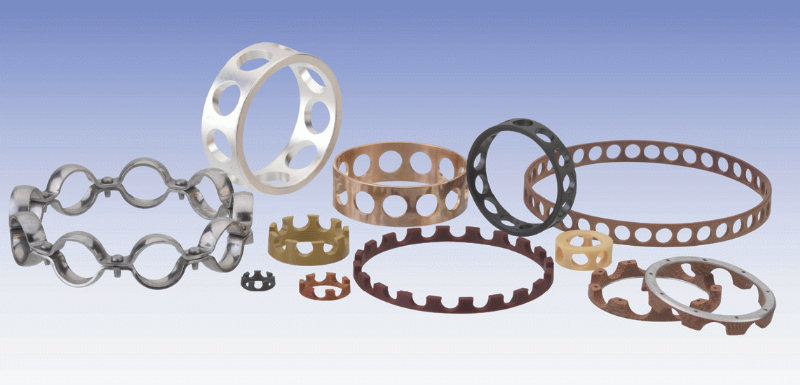 In applications involving rolling element bearings, proper attention to cage design and materials selection is essential in order to ensure reliable, long term bearing performance, says Gary Hughes, product engineering manager at The Barden Corporation
In applications involving rolling element bearings, proper attention to cage design and materials selection is essential in order to ensure reliable, long term bearing performance, says Gary Hughes, product engineering manager at The Barden Corporation
The basic purpose of a cage is to maintain uniform ball spacing, but the cage may also be to reduce torque, and minimise build-up of heat and resist harsh environments.
In separable bearings, the cage is designed to retain the balls in the outer ring so the rings can be handled separately. Cage loading is normally light, but acceleration and centrifugal forces may develop and impose cage loading. Also, it may be important for the cage to accommodate varying ball speeds that occur in certain applications.
Cages are piloted by the balls or one of the rings. Typically, low to moderate speed cages are ball-piloted. Most high-speed cages have machined surfaces and are piloted by the shoulder of either the inner or outer ring.
High precision deep groove and angular contact ball bearings are available with several types of cages to suit a variety of applications. Cost is a factor with bearing cages, but many others enter into cage design and cage selection, including: low coefficient of friction with ball and race materials; compatible expansion rate with ball/ring materials; low tendency to gall or wear; the ability to absorb lubricant; dimensional and thermal stability; suitable density; adequate tensile strength; creep resistance; high temperature; and corrosive atmospheres.
Deep Groove Bearing Cages
Deep groove bearings are typically assembled by offsetting the rings, inserting the balls, centralising the rings, then spreading the balls and inserting the cage. Due to this assembly method, it must be possible to either insert the cage from one side (snap type cage) or insert half the cage from either side and then secure the two halves together (clinched or riveted cage).
For low to moderate speed applications, Barden offers a range of pressed steel cages. The crown cage is the basic cage for the smallest miniature bearings. Larger miniature bearings are supplied with clinched ribbon cages, and the largest bearings tend to be supplied with riveted ribbon cages. One of the benefits of these low speed cages is that they are resistant to operating temperatures above 300°C.
Both the Crown and Ribbon types are used at moderate speeds and are ideally suited to bearings that are grease or oil lubricated and equipped with seals or shields. The W-type is a low-torque pressed metal cage developed by Barden, and is available in many instrument sizes. It is loosely clinched to prevent cage windup (a torque increasing drawback of some cage designs) in sensitive low-torque applications.
For higher speeds, Barden offers both the one-piece phenolic snap-in TA-type, and the two-piece riveted phenolic, aluminum-reinforced T cage. The aluminum reinforcement provides additional strength, allowing this high-speed cage to be used in most standard width sealed or shielded bearings, whereas the TA cage offers low vibration in applications where this extra strength is not required.
Angular Contact Bearing Cages
Phenolic is also the cage material used by Barden in many of its miniature and instrument angular contact bearings. The cages are machined halo (B and H) types with high-speed capability. A feature of these cages is their outer ring land guiding, which allows lubricant access to the most desired point – the inner ring/ball contact area.
H-type phenolic cages are one-piece units with a through pocket halo design. They are suitable for high-speed general-purpose applications. The B-type cage is also intended for high-speed, general- purpose applications, but in separable bearings. The design of this cage includes ball pockets, which hold the balls in the outer ring when the inner ring is removed.
For high temperature applications, the cages of Barden’s larger spindle and turbine angular contact bearings are machined from bronze or steel – the latter silver-plated. Most of these designs are also outer ring land guided for optimum bearing lubricant access and maximum speed capability.
Non Standard Cages For Specialised Applications
Where a standard cage does not meet end user requirements, Barden can develop specialised cages for unusual applications.
Many aerospace bearings, which must be lightweight and able to operate at high speeds, utilise either one-piece snap phenolic cages or two-piece aluminium-reinforced riveted phenolic cages. Bronze cages are also used in aerospace systems, particularly in high speed, high temperature conditions such as the generator bearings used in aerospace APUs. In some high speed, high temperature applications, silver-plated steel cage designs are the preferred option. In the case of lubricant failure, this silver-plating acts like a solid, dry lubricant.
In space applications, where bearings must operate in a vacuum at relatively slow speeds and loads, cages are often made from PTFE, molybdenum sulphide and glass-fibre reinforced material acting as a dry lubricant.
Turbomolecular and Dry Pumps
For grease-lubricated turbomolecular bearings, phenolic cages are typically used, as they can operate at high speeds and offer extended lubricant life. For oil-lubricated turbomolecular bearings, machined plastic (Polyamide-imide) cages are the preferred option. These provide good resistance to high temperatures and help to feed oil into the bearings. Here, the cage is designed as part of the oil circulation system, redirecting the oil to difficult to reach areas of the bearing.
In dry pump applications, although the bearings operate at slower speeds, they have to resist higher contamination levels and poor quality lubricants over the complete life of the bearings. Therefore, steel riveted cages are the preferred choice. However, current developments in high strength plastic (PEEK) cages are pushing this technology into higher speed applications.
The Barden Corporation
T: 01752 725531


